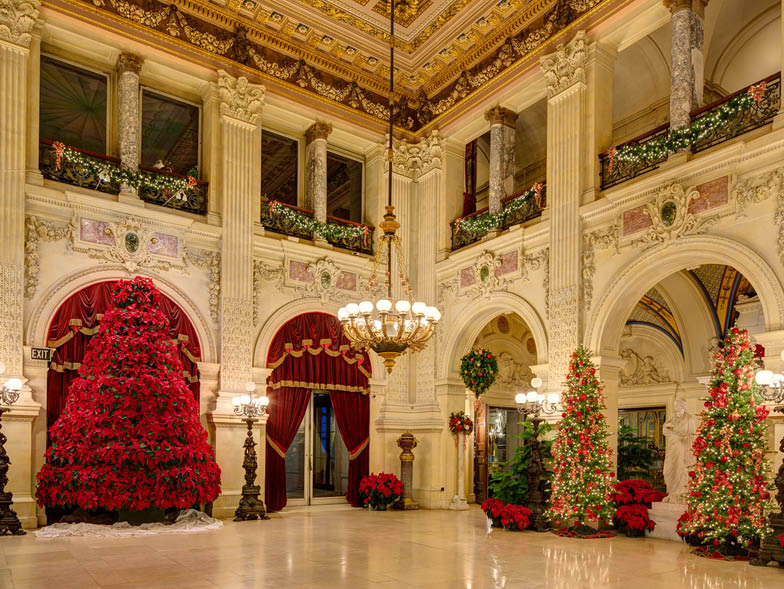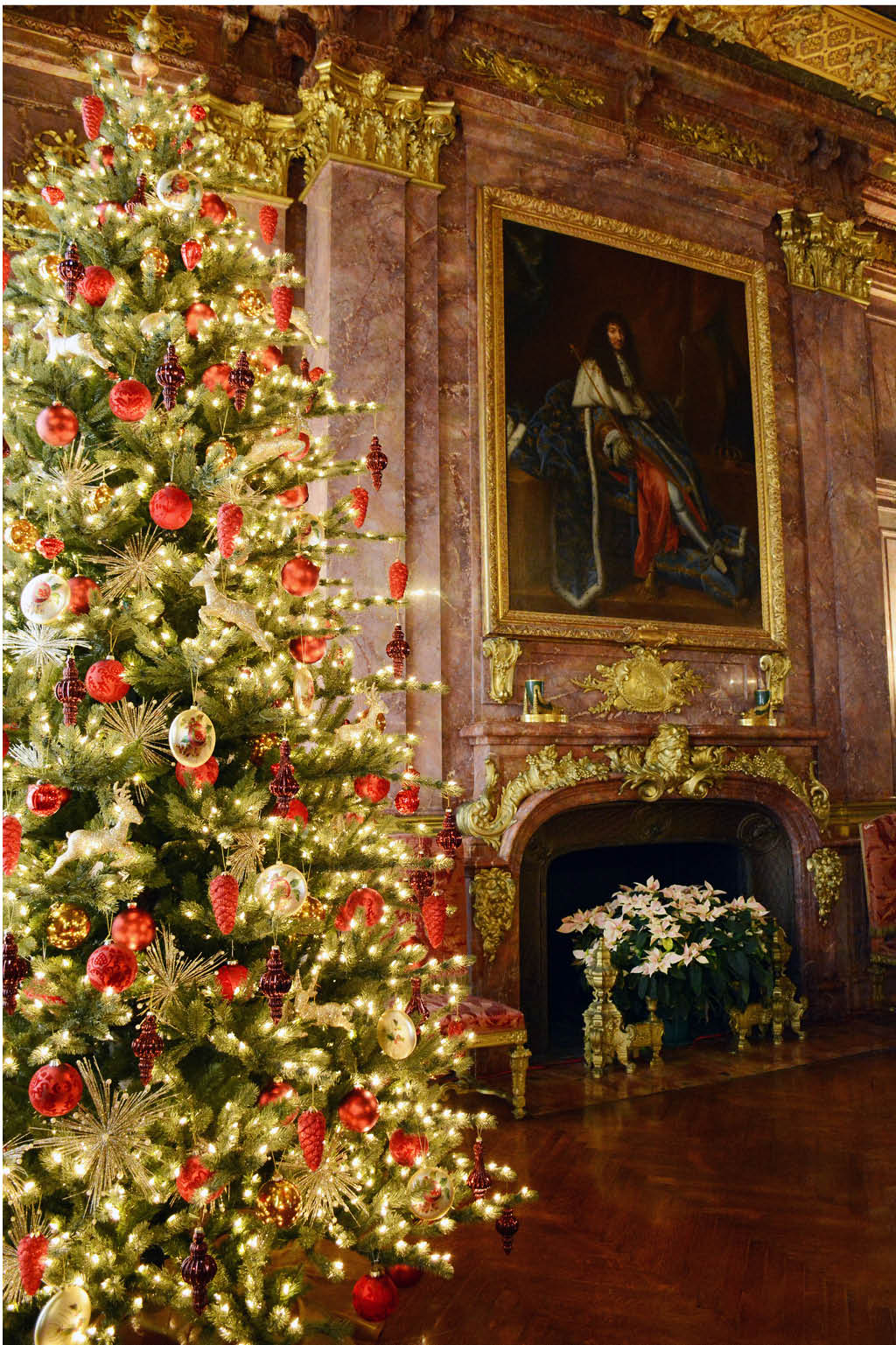Tinsel and Tradition
Founded in 1639, Newport, Rhode Island, is one of the country’s most historically significant cities. Helping to protect that history is The Preservation Society of Newport County, which oversees several magnificent, centuries-old houses. Preservation Society communications manager Andrea Carneiro discusses the organization’s role as caretaker of the mansions, its impact on the city, and its annual six-week holiday event, Christmas at the Newport Mansions.
Tell us about the history of The Preservation Society of Newport County:
The Preservation Society of Newport County is a private, nonprofit organization whose mission is to protect, preserve, and present an exceptional collection of house museums and landscapes in one of the most historically intact cities in America. Its eleven historic properties and landscapes—seven of which are National Historic Landmarks—exemplify three centuries of the finest achievements in American architecture, decorative arts, and landscape design, spanning from the colonial era to the Gilded Age.
The Preservation Society was founded in 1945 by a small group of concerned citizens who banded together to save an important colonial building on the Newport waterfront, the Nichols-Wanton-Hunter House, built in 1748, from demolition. They organized a group called The Georgian Society to purchase Hunter House. The name of the organization was changed shortly thereafter to The Preservation Society of Newport County.
In 1948, in order to raise money to restore Hunter House, the Countess Laszlo Szechenyi (Gladys Moore Vanderbilt) agreed to open her family’s summerhouse, The Breakers, for tours. With those revenues, the Preservation Society was able to restore Hunter House and went on to save and restore other threatened colonial properties. The Preservation Society acquired the other properties it operates today between 1962 and 1994, and, in 2004, the Preservation Society was awarded accreditation by the American Alliance of Museums, a mark of excellence in the museum community. In 2016, admissions to the Preservation Society’s properties, collectively known as the Newport Mansions, surpassed one million for the first time, making the Newport Mansions the only museum in New England outside of Boston to host more than a million tours in a single year.
What does the Preservation Society do to maintain these eleven historic mansions throughout the year?
The Preservation Society today maintains a total of twenty-four buildings, eighty-eight acres of gardens and landscape (including 1,800 trees), and 55,000 museum-quality artifacts in its collections on an annual budget of approximately $21 million. We employ four hundred people, including curators, conservators, architects, researchers, archivists, tour guides, landscapers, carpenters, masons and other skilled craftsmen, ticket and retail sales associates, and support staff. All are involved in the ongoing maintenance, preservation, restoration, and presentation of the buildings, landscapes, and collections.

What would you say have been the Preservation’s Society’s most challenging undertakings over the years?
There have been many, many challenges over more than seventy years. Conservation, restoration, and preservation work are ongoing and nonstop. Maintaining buildings built between 1748 and 1902, visited annually by hundreds of thousands of people, is a monumental and expensive undertaking. As a private, nonprofit organization, the Preservation Society does not receive direct taxpayer support. Its funding comes from ticket sales, special events, retail sales in its stores, and donations from generous supporters. Ensuring that the buildings remain in the best possible condition for the enjoyment and education of future generations is the ongoing challenge and responsibility.
How vast are the mansions that are decked out for Christmas?
During the holidays, we decorate three of the historic houses, which have a grand total of over 225,000 square feet. The Breakers has seventy rooms and 138,000 square feet of interior space on a thirteen-acre estate; The Elms sits on a ten-acre estate and constitutes about 60,000 square feet of living space. Marble House is about 30,000 square feet.
Great effort goes into restoring and maintaining the mansions so they retain their nineteenth-century charm, but what modern upgrades have also been necessary?
The usual upgrades you would expect have been made: electrical and heating, and safety and security systems, for example. Sprinklers have been installed in some spaces. In 2016, a geothermal climate control system was installed at Chepstow, and this year a similar system, though on a far larger scale, was installed at The Breakers. The challenge is to meet modern-day needs without disturbing the historic fabric of the buildings.
In our greenhouses, poinsettias, lilies, evergreens, and other flowers and plants used at Christmas are planted and nurtured year-round. Installation of the interior decorations begins in mid-October, managed by Jim and a group of volunteers from local garden clubs, many of whom have been participating for many years.
How many people prepare the mansions for the six-week Christmas at the Newport Mansions event? When does the preparation begin? How long does it take?
Preparations for Christmas begin the previous January. Our curator of historic landscapes, Jim Donahue, travels to trade shows and gift shows to scout out and purchase new decorations and ornaments and begins planning for the following year. In our greenhouses, poinsettias, lilies, evergreens, and other flowers and plants used at Christmas are planted and nurtured year-round. Installation of the interior decorations begins in mid-October, managed by Jim and a group of volunteers from local garden clubs, many of whom have been participating for many years. In 2016, for example, Jim’s volunteers worked a total of 270 hours. Our curators and conservators participate in preparing and displaying historic china, silver, and glassware. Caretaking staff and gardens and grounds crews install trees and wreaths on the exterior of the buildings, and our floral designers create the magnificent fresh floral displays in various rooms of the houses.

How many trees and plants are used for the event?
Because of Rhode Island fire codes, all of the lighted Christmas trees displayed in the mansions are artificial. In 2016, there were a total of twenty-eight trees among the three houses, ranging in size from three feet to twelve feet. Several thousand poinsettia plants are used throughout the houses, most of which are grown in our own greenhouses, along with lilies and other fresh flowers and potted evergreens.
As these three mansions weren’t primary residences, and thus wouldn’t be holiday homes, how do you determine how to decorate for the holidays? Do you try to keep it consistent each year, or is there a different annual theme?
Some things stay the same, but there is always some new feature or decorative theme. Many decorations are rotated among the three houses and recombined to create a new look in a different setting.
You are correct that these houses would not have been decorated for Christmas. What we are doing is creating a fantasy of sorts for the thousands of visitors who come through the mansions during the holiday season. The decorative scheme for each house is tailored to the colors and style of each individual room. For instance, The Breakers features a lot of red and gold, and very large ornaments to fit the scale of the very large rooms. At The Elms, which is styled as a French hunting lodge, the ballroom is decorated in a village scheme, with sleighs, mannequins wearing period clothing, and ornaments that feature pinecones and owls.
With such opulent settings, how do you make the Christmas decorations stand out while also complementing (and not being overwhelmed by) the existing Gilded Age architecture and decor?
As mentioned earlier, it’s all about scale. The houses are elaborately decorated in their own right, and the key is to augment, not detract from, the surroundings. That’s why color schemes are also so important. Ornaments and decorative pieces are matched as much as possible to the color scheme and the decorative style of each room. For instance, at Marble House, the Christmas tree in the Gothic Room is decorated with Gothic-style ornaments, including stained glass pieces.
On average, how long does it take to tour the decorated mansions during the holidays? How many rooms can be visited in each? Do most visitors take tours?
The tours remain the same all year round. Visitors to The Breakers, The Elms, and Marble House take an audio tour through each house, so the length of the tour is completely customizable to each visitor’s interest and schedule. The main tour of each house runs between thirty-five and forty-five minutes. In each house, there are also supplemental subject stops in each room, which visitors can listen to for additional information, making the full tour length up to an hour or so. And people are welcome to spend as much time as they like in each room.
What are some of the highlights of Christmas at the Newport Mansions?
There are some decorative themes that recur from year to year. For instance, at The Breakers, one of the most familiar and anticipated features is the fifteen-foot-tall poinsettia tree in the Great Hall, made up of about 150 individual plants. Also at The Breakers, the upper loggia is transformed into a winter village, with working model-scale replicas of the Vanderbilts’ New York Central Railroad. At Marble House, visitors enjoy the Gothic splendor of the Gothic Room, and also the fireplace mantels, which are decorated each year by local garden clubs. The Elms ballroom features the previously mentioned winter village, with sleighs, trees, and period-costumed mannequins. Also displayed at The Elms is a collection of antique toys and stuffed animals. All of the houses have white candles in their windows (a Colonial Newport tradition).
Among the most prominent are the annual Newport Flower Show in June, now in its twenty-second year, and the Newport Mansions Wine and Food Festival in September, now in its twelfth year.
What other notable events take place at the mansions throughout the year?
The Preservation Society hosts a variety of special year-round events. Among the most prominent are the annual Newport Flower Show in June, now in its twenty-second year, and the Newport Mansions Wine and Food Festival in September, now in its twelfth year. We also have an Easter Egg Hunt at Rosecliff, a children’s party at Green Animals Topiary Garden in July, year-round lectures and films, and a midsummer black tie dinner dance.
What do the mansions mean for Newport itself, both during the holidays and all year long?
A recently completed economic impact study has determined that Preservation Society operations, including visitor spending, payroll, and purchasing, generate over $109 million annually in economic activity for the city of Newport. In addition to the 400 full-time and seasonal workers the Preservation Society employs directly, this economic activity supports the employment of more than 1,250 people in related jobs in the private sector, such as workers at restaurants, hotels, gas stations, boutiques, and tent companies, as well as caterers, florists, and musicians. We are proud of the important role we play in the city’s economy and history.
For more info, visit newportmansions.org.






















